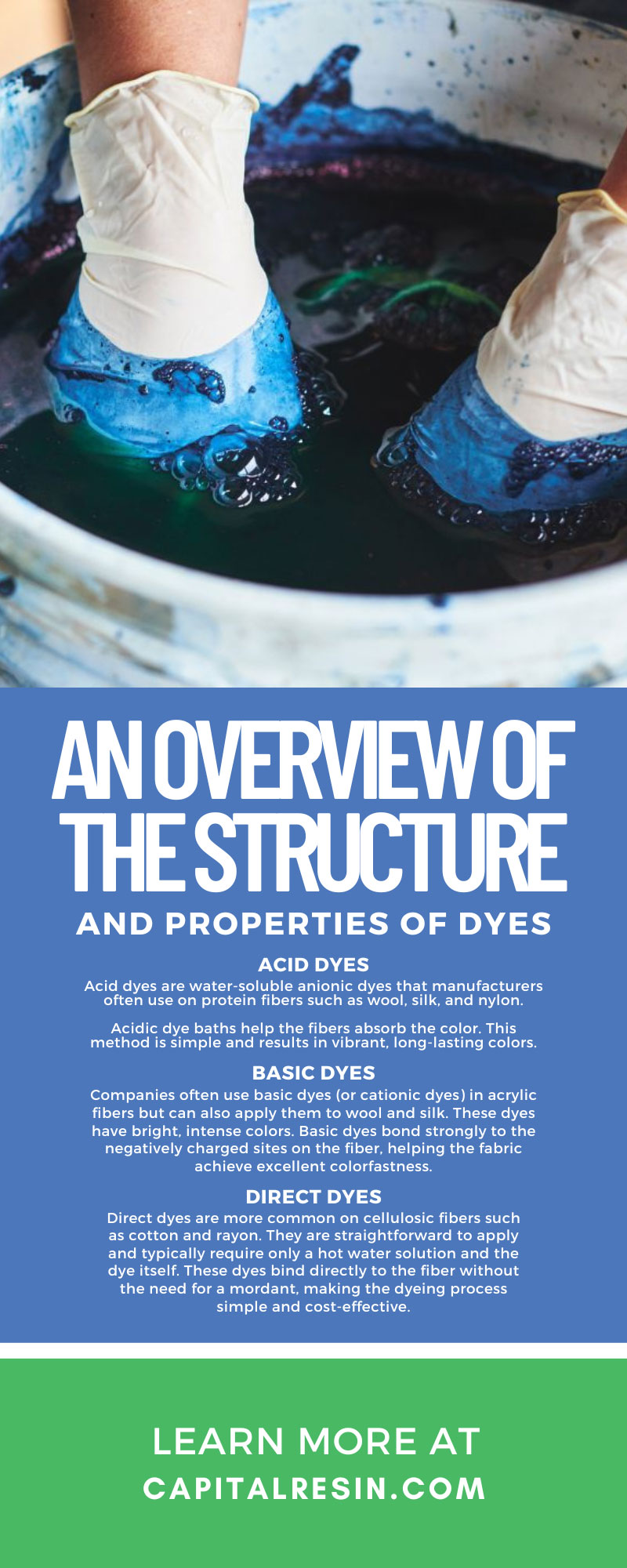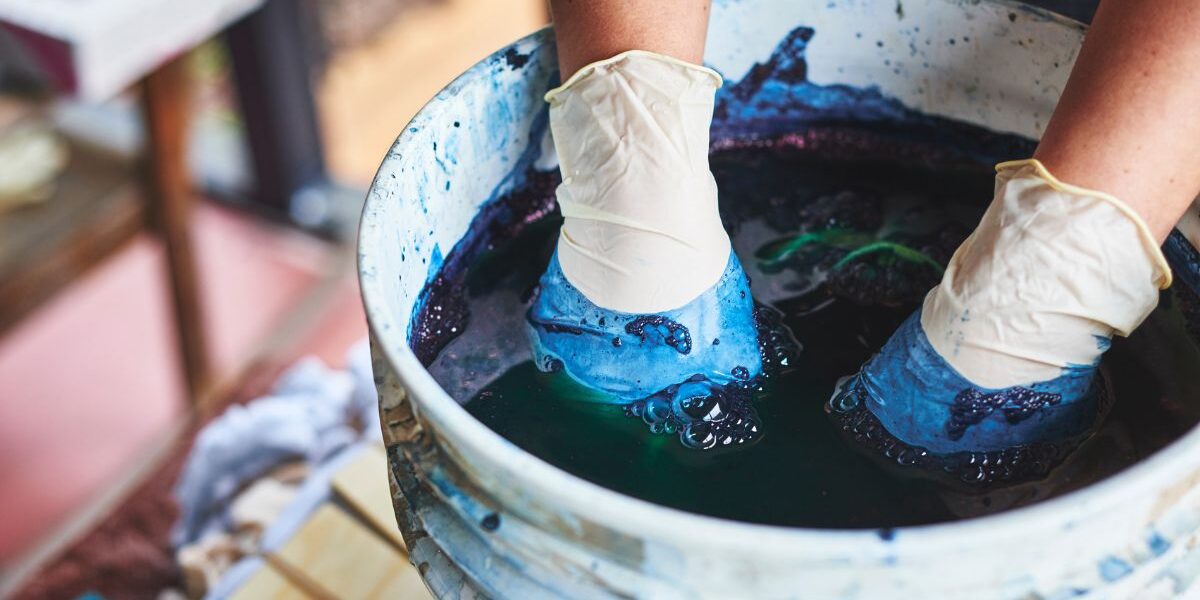Dyes are one of the main ways that one can bring color and personality to materials, fabrics, and products. From ancient times to modern applications, adding color is an ongoing process that we always strive to improve.
Can we make colors more vibrant or create dyes with fewer negative side effects? Today, Capital Resin Corporation is here to provide an overview of the structure and properties of dyes and go over their history, chemical compositions, and practical applications.
What Are Dyes?
At a basic level, dyes are substances used to add color to materials. Cotton is naturally white, but we can use dyes to make cotton t-shirts in red, blue, green, or any other color you can imagine.
Unlike insoluble pigments, dyes are soluble particles that chemically bind to what manufacturers apply them to. This binding process ensures the color remains vibrant and durable. Manufacturers use dyes in numerous applications, including textiles, food, cosmetics, and pharmaceuticals.
Historical Background of Dyes
The history of dyes dates back thousands of years. Early civilizations such as the Egyptians and the Chinese developed methods for extracting natural dyes from plants, insects, and minerals. The discovery of synthetic dyes in the 19th century revolutionized the industry, offering a range of colors and greater stability.
Chemical Structure of Dyes
The chemical structure of dyes is how we use them to create colors on materials. Dyes typically consist of two main components: the chromophore and the auxochrome.
Chromophore
The chromophore is the part of the dye molecule responsible for its color. This component allows the dye to absorb specific wavelengths of light and reflect colors due to the presence of conjugated systems that alternate between double and single bonds. The absorbed wavelength corresponds to the color that the dye exhibits. Common chromophores include azo groups (-N=N-), carbonyl groups (C=O), and nitro groups (-NO_2).
Auxochrome
Auxochromes are groups of atoms that attach to the chromophore and modify its ability to absorb light. They typically consist of electron-donating groups such as hydroxyl (-OH) or amino (-NH_2) groups, which intensify the color and increase solubility in water. Auxochromes can also affect the color’s shade by shifting the absorption maximum to different wavelengths, a phenomenon known as the bathochromic shift.
Types of Dyes
We categorize dyes into various types depending on their chemical structure, application, and the methods used to apply them to substrates. Here are a few of the most common types of dyes:
Acid Dyes
Acid dyes are water-soluble anionic dyes that manufacturers often use on protein fibers such as wool, silk, and nylon. Acidic dye baths help the fibers absorb the color. This method is simple and results in vibrant, long-lasting colors.
Basic Dyes
Companies often use basic dyes (or cationic dyes) in acrylic fibers but can also apply them to wool and silk. These dyes have bright, intense colors. Basic dyes bond strongly to the negatively charged sites on the fiber, helping the fabric achieve excellent colorfastness.
Direct Dyes
Direct dyes are more common on cellulosic fibers such as cotton and rayon. They are straightforward to apply and typically require only a hot water solution and the dye itself. These dyes bind directly to the fiber without the need for a mordant, making the dyeing process simple and cost-effective.
Reactive Dyes
Reactive dyes form a covalent bond with the fiber, making them an ideal choice for dyeing cotton and other cellulose-based fibers. These dyes are highly stable and exhibit excellent wash and light-fastness. The formation of a chemical bond between the dye and the fiber ensures that the color is both vibrant and durable. Each type of dye has unique properties and applications, making the choice of dye crucial depending on the material and desired outcome.
Properties of Dyes
Key properties include solubility, light-fastness, and wash fastness. Solubility determines how well a dye can penetrate a fiber, while light-fastness refers to the dye’s resistance to fading when exposed to light. Wash fastness indicates how well the dye can withstand washing without bleeding or fading.
Industrial Applications of Dyes
Dyes are vital in various industries. The textile industry uses dyes to color fabrics and garments to enhance their visual appeal. The food industry uses dyes to improve their products’ appearance, making them more attractive to consumers. Cosmetics manufacturers use these dyes in products such as lipsticks, eyeshadows, and hair dyes. Pharmaceuticals also use dyes to color medications and other products.
Environmental Impact of Dyes
The production and use of dyes have significant environmental implications. Many synthetic dyes use petrochemicals, contributing to pollution during their production.
Effluents from dyeing processes can contaminate water sources, affecting aquatic life and human health. Efforts to develop eco-friendly dyes and sustainable dyeing processes are ongoing, aiming to reduce the dye industry’s environmental footprint.
Challenges in Dye Chemistry
The field of dye chemistry has several distinct challenges. Developing dyes that are both effective and environmentally friendly is a key concern. Ensuring the safety and non-toxicity of dyes, particularly those used in food and cosmetics, is crucial.
Companies often strive to create dyes that can withstand harsh conditions such as high temperatures or exposure to other chemicals. For example, creating dyes that are less likely to bleed onto other garments when you do laundry is a pressing concern.
The Future of Dye Technology
The future of dye technology depends on various advancements in sustainability and innovation. Researchers are exploring the development of dyes from renewable resources, aiming to reduce reliance on petrochemicals and minimize environmental impact.
Digital printing technology also revolutionizes the textile industry by enabling precise and efficient dye application, reducing waste and resource consumption. A concerted effort toward sustainability and advanced functionalities is vital in shaping a greener and more efficient future as dye technology evolves.
Capital Resin Corporation, a leading aromatic sulfonic acid manufacturer, dedicates itself to providing high-quality chemical solutions for your industrial needs. With our commitment to innovation and customer satisfaction, we aim to create custom chemical solutions and sulfonic acids to meet your needs.
Partner with us today to experience our exceptional chemical expertise and elevate your chemical manufacturing processes. Contact Capital Resin Corporation now to learn more about how we can support your business.








